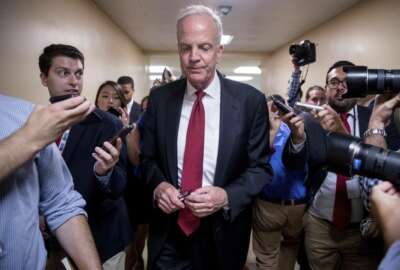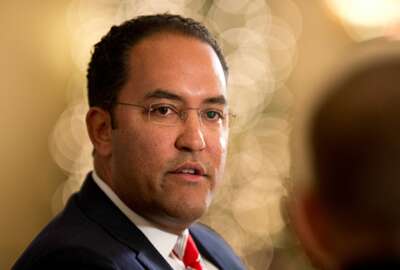
With 17 existing working capital funds, some CIOs excited about added flexibilities of MGT Act
The Modernizing Government Technology (MGT) Act made it through the defense authorization bill conference intact.
The real change the Modernizing Government Technology (MGT) Act will bring agency chief information officers, now that it has cleared one of the final hurdles to becoming law, is not the creation of a working capital fund. But rather, it’s the flexibility and specific requirements for using the money in the working capital fund that may be the MGT Act’s biggest impact.
House and Senate conferees agreed to the 2018 defense authorization bill last week and included the MGT Act provision.
The NDAA says agencies can establish working capital funds for modernizing technology and can reprogram or transfer funds for up to three years to modernize or retire legacy systems.
Joe Klimavicz, the Justice Department CIO, said at a Partnership for Public Service event before Congress finalized the NDAA that the MGT Act would potentially help his agency improve upon its growing modernization effort.
Klimavicz said Justice already saved or avoided spending more than $300 million by consolidating to one email system and optimizing and reducing data centers from 110 to 30.
Justice also is moving to the cloud with two dozen initiatives, and is adding advanced data analytics.
But Klimavicz said Justice’s current working capital fund includes only one-year money, meaning he has to spend it all before the end of the fiscal year.
“If I had a multi-year, like a three-year, which is being considered out there, then I could accumulate enough money to make these modernization or transformation efforts over the hump into a better place and also with some bigger systems,” he said at the PPS event. “They all require modernization, but right now, you have to do everything in a one-year timeframe.”
Klimavicz’s challenges are not unique to Justice.
According to the White House budget request for fiscal 2017, 17 agencies currently have working capital funds. For instance, the Commerce Department has working capital funds at the headquarters level, the Census Bureau and the National Institute of Standards and Technology. Additionally, the Environmental Protection Agency, GSA and the departments of Justice, Treasury, State, Labor, Transportation and Interior are among the agencies with working capital funds.
And the challenge is that none are the same and all have different requirements for one-year money or multi-year money, or how that money is accumulated and even spent.
It was because of this widespread use of working capital funds that served both as an obstacle and as an opportunity for the MGT Act.
The Interior Department is facing a similar challenge as Klimavicz. While the agency funds its CIO’s office through a working capital fund and its no-year funding, the CIO is limited to how they can use the money.
Sylvia Burns, Interior’s CIO, said at the PPS event before the MGT Act passed, the bill would give her office the ability to target funds to the most pressing areas.
“I think the potential change to the working capital fund that we have now, which we have to have much more conversations about, it could offer that capability of taking savings in IT, parking the money in a modernization fund, then we could have some sort of process, potentially similar to the process that OMB outlined in that legislation, about having a board with the proposals coming in and selections, monitoring and putting the resources to make it successful,” she said. “That’s potentially how we could do stuff in the future, but again, much more to talk about inside the department.”
Burns said spending money through the current working capital fund is managed by a consortium with representatives from all of the components, bureaus and offices that pay into it. She said there is a charter that outlines roles and responsibilities, how the board will function as issues up to the bureaus and offices for voting.
Burns added it would be helpful for IT to traverse the different appropriations across the agency.
“This doesn’t exist and I know it’s a contentious issue. I know my agency wouldn’t necessarily support the idea of having a single appropriation for IT, but somehow having more flexibilities, and I hope the MGT Act actually gives that to us, to be able to go through the different bureau appropriations for what is spent on IT and have some more fungibility in that space,” she said.
Burns, Klimavicz and Scott Blackburn, the acting CIO at the Veterans Affairs Department, all agreed that having enough money to modernize and transform IT systems isn’t the problem.
“We don’t spend that money well,” Burns said. “I think it is our responsibility as CIOs and just stewards of taxpayer’s money to find a better way to spend that money. The way I’m trying to do it at Interior is I’ve created a very collaborative environment with me and the associate CIOs at our bureaus. We are just agreeing to work together on stuff, including if we want to invest in something. We haven’t done this yet, so maybe the proof is in the pudding, but maybe we all agree that we will not do that thing we were going to separately, but direct the money to the thing we want to do together. In the next year, we will see how this plays out.”
Blackburn said because transformation efforts need investment, he’d like to see some help come from the White House.
“The only way to attack this problem is to be aggressive, to make the appropriate investments and have a good plan, and to be held accountable,” he said. “One of the things I’d say to the oversight committee or Office of American Innovation is let’s together build that plan. Over a longer period of time, say five-to-10 years, we will retire these systems when we get the new system online, and there will be the cost benefits, the resource benefits and hold the department accountable over that longer period of time to include when we are retiring and when we are getting the cost savings.”
Blackburn said VA cannot continue to spend $4.5 billion a year on IT, especially on so many legacy systems. He said that is why to drive down spending is critical, but it will take time, investment and being held accountable.
And the passage of the MGT Act is the first step toward creating that accountability. The Office of Management and Budget has said numerous times over the past year that when the modernizing bill becomes law, it will be ready to start running.
Return to the Reporter’s Notebook
Copyright © 2025 Federal News Network. All rights reserved. This website is not intended for users located within the European Economic Area.
Jason Miller is executive editor of Federal News Network and directs news coverage on the people, policy and programs of the federal government.
Follow @jmillerWFED
Related Stories

Senate concerns slow down IT modernization compromise bill




